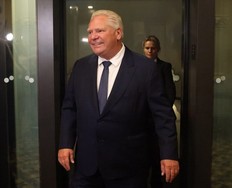GOLDSTEIN: Remember Carney’s new carbon taxes? They’re still coming

Article content
Before Mark Carney became prime minister, he was the world’s leading corporate lobbyist for higher carbon taxes to fight climate change.
After becoming prime minister, not so much.
His one concrete action to date has been to remove his predecessor’s unpopular consumer carbon tax.
But Carney never said he was scrapping carbon taxes.
His own media release when he announced his new policy on Jan. 31, while running for the Liberal leadership, was: “Mark Carney presents plan for change on consumer carbon tax.”
Changing something is not killing it.
What Carney actually said he would do was to fold the consumer carbon tax into what he described as an “improved and tightened” industrial carbon tax, known as the Output Based Pricing System (OBPS).
He said this reformed carbon tax would make “big polluters” pay the added costs they face of using fossil fuel energy to create almost all goods and services, without passing them along to Canadians in higher prices.
He also said that instead of carbon tax rebates, this would include “a system of incentives to reward Canadians for making greener choices,” which the previous Liberal government said the rebates were supposed to accomplish.
The problem is that since carbon taxes impose a new cost on society — the cost of emitting industrial greenhouse gas emissions into the atmosphere — someone must pay it and it always ends up being Canadians, either as taxpayers or consumers.
Carney also said he would create a second carbon tax known as a Carbon Border Adjustment Mechanism.
That means imposing carbon tariffs on foreign goods imported into Canada from countries that, in Canada’s view, don’t have credible climate change policies.
For example, the Carney government could impose a tariff on U.S. goods imported into Canada — meaning higher prices for Canadians — because the U.S. doesn’t have a national carbon tax.
Given Carney’s long-standing support for higher carbon taxes, it’s logical to assume that while he has gone silent on his carbon pricing policies, he hasn’t abandoned them, despite having a lot of other issues on his mind at the moment.
One of those issues — his legislation to green-light “nation-building projects” and to eliminate federal barriers to inter-provincial trade now before the Senate — will increase Canada’s emissions at least in the short term.
That’s because, competently implemented — and that’s a big if — they will increase economic activity, which increases emissions because almost all goods and services today are created using fossil fuel energy.
New oil and natural gas pipelines, for example, will increase Canada’s emissions.
While Carney has talked about supporting “decarbonized” oil and gas, our current technology for lowering emissions through such measures as carbon capture and storage, lags far behind our ability to build pipelines and other “nation-building” infrastructure policies.
Another problem is that the previous Liberal government’s policy of dramatically increasing Canada’s immigration levels has put upward pressure on emissions,
On the plus side, increasing Canada’s exports of our vast reserves of natural gas would help reduce emissions globally, because replacing coal-fired electricity with natural gas is one of the most effective ways, given current technologies, to lower global emissions.
Exporting safe Canadian nuclear technology internationally would also have a beneficial effect.
For now, however, because he’s busy with other things, we don’t know how Carney’s new carbon tax regime will roll out.
Just remember that, unless he’s had a massive conversion on the road to Damascus about carbon taxes, it’s definitely coming.











Postmedia is committed to maintaining a lively but civil forum for discussion. Please keep comments relevant and respectful. Comments may take up to an hour to appear on the site. You will receive an email if there is a reply to your comment, an update to a thread you follow or if a user you follow comments. Visit our Community Guidelines for more information.